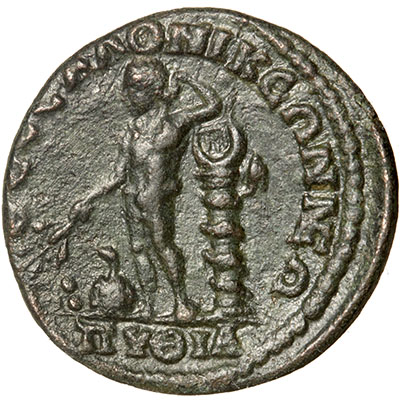 |
| Bronze coin of Gordian III from Thessalonika showing Apollo. |
I am mostly focused on natural history now, but I still pick up an ancient coin now and then if it looks interesting.
This is a bronze coin from Thessalonika in the reign of the Roman emperor Gordian III. Like one of my previous coin posts,
Apollo from Didyma, it shows the god Apollo, but in another of his many roles.
Here he is the patron deity of the Pythian games. Like the Olympics, these games were an important and widely known event. They began as a singing contest, where the god's praises would be sung to the accompaniment of the kithara, a concert-sized lute. This explains the presence of a lute on the coin. Other contests, including chariot racing and athletic events, were added over time.
The snake winding around the column represents Python, defeated by Apollo when he first took up residence at Delphi, near the site of these games. On the ground is a basket, described as a prize basket with a palm branch, though the object in the basket looks very much like another snake to me. There should be five apples there too, but, probably because the strike of the coin is poor at that point, I can only see two.
When Apollo holds a branch downwards like that it is most likely a laurel, the type that we call Bay. He is sprinkling water from it as a ritual cleansing gesture.
The coin's legend is ΘЄCCAΛONIKЄΩN NEΩ ΠYΘIA, or THESSALONIKEWN NEW PYTHIA in Latin lettering. The first word says where the coin is from. NEΩ is short for NEΩKOPON, a title that could be given to provincial towns that maintained temples to the Roman emperors, and the coin adds this title as a sort of boast. And PYTHIA indicates either the games themselves, or the period between games, which was known as a Pythiad. At this period a Pythiad had the same four-year interval as the Olympics, so that they would not clash.
A final note about the legend. This coin uses the curved Є rather than the Latin E, and joins letters together sometimes, which saves space and reduces the work of carving the die. The N and E of NEΩ are ligate, and this E is therefore forced to have a straight back. So it seems that the engravers didn't see any real difference between the two forms of the letter.















